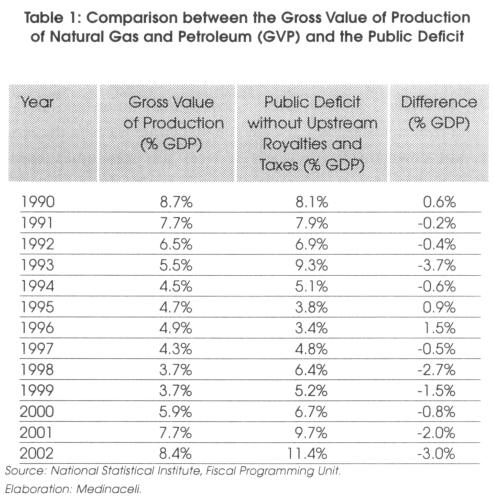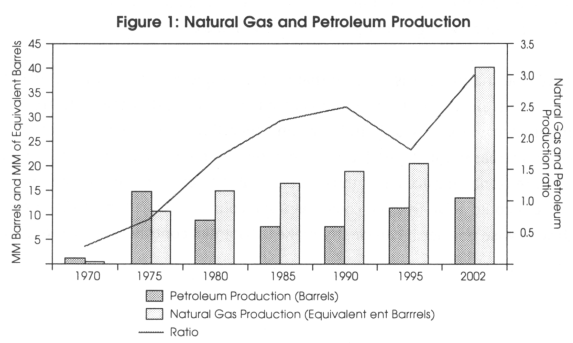Services on Demand
Journal
Article
Indicators
-
 Cited by SciELO
Cited by SciELO -
 Access statistics
Access statistics
Related links
-
 Similars in
SciELO
Similars in
SciELO
Share
Revista Latinoamericana de Desarrollo Económico
Print version ISSN 2074-4706On-line version ISSN 2309-9038
rlde no.2 La Paz Apr. 2004
DISCUSSSION ARTICLE
Can the Oil Sector Solve the Problem of the Fiscal Deficit in Bolivia?
Sergio Mauricio Medinaceli Monrroy
The answer is no, at least in the short term. I wanted to begin with the answer in order to motivate the reading of a problematic topic, namely the relationship between the extraction of petroleum and natural gas and its fiscal contribution in the form of royalties and taxes. In what follows, I want to present some points on a subject that, although obvious from the numbers, do not seem to be common knowledge.
Before beginning let me delimit the object of study. The productive activities of the oil sector are generally divided in two groups: a) exploration and extraction and b) refinement and commercialization. Usually the first group is called the upstream sector and the second downstream; transport services are sometimes considered as a separate group, mid stream, or within the other two groups. The present discussion will concentrate on the upstream, because the taxes which the downstream pays are generally transferred to the final consumer. Therefore the fiscal burden in this sector will depend on the fiscal and energy policy of the moment, and therefore, the discussion between the downstream and the fiscal deficit loose relevance, since the last could be solved through a strong local tax burden on the final prices of products derived from petroleum.
Table 1 presents the gross value of the production of natural gas and petroleum (GVP) in Bolivia (as percentage of GDP), the deficit of the Public Sector (PS) (also as percentage of GDP) and the difference between the two concepts, during the period 1990-2002. According to the National Statistical Institute, GVP does not include the payment of operation services, but it incorporates the following concepts: a) payment of royalties and taxes, b) operation expenses, c) capital expenses and d) company profits. On the other hand, the deficit of the PS presented here considers the cost of the reform to the pension's system implemented in second half of the nineties but do not take account the upstream royalties and taxes 1.

What does this table say? That, if in the last six years the upstream sector in Bolivia had given the total of its gross income to the State, assuming an irrational situation in which the company, for example, is become indebted to cover its operation and capital expenses and obtains zero benefits, this payment had not been sufficient to cover the PS deficit (see Annex). Moreover, this situation exists independently of whether the sector is administered by the State or the private sector, since the numbers exclusively depend on the volumes of production and the sale prices.
Then the following question arises: ¿Why is there a belief that the upstream business in Bolivia is worth billions of dollars? I found that a reasonable explanation is the amount of investment that the sector has received lately. According to numbers published by the State Oil Company (YPFB) the accumulated investment during the period 1997-2002 is greater than $US 2.600 million and it appears that the public tends to relate the total level of accumulated investments to the gross income of the sector. What happens is that the capital returns in this sector are very low due to the reduction of external demand and, more importantly, due to the low price of natural gas in both external and internal markets.
In the second part of this article I will try to elaborate on the last sentence of the previous paragraph, the low capital returns and the low natural gas prices. Figure 1 presents the production of petroleum and natural gas since 1970, in barrels in the case of liquids and in barrel equivalents in the case of natural gas, and the ratio between the two on the right axis.

During the seventies the petroleum production was greater than the natural gas production; in this period the ratio presented is smaller than one. However, since the eighties the natural gas production has been greater than that of liquids. For example, in 2002, Bolivia obtained 3 barrel equivalents of natural gas for each barrel of petroleum. Certified reserves of petroleum and natural gas in Bolivia suggest that this trend will continue in the future, that is, natural gas production will increase faster than the production on liquids.
Which are the problems with this tendency? The first problem becomes clear when comparing the prices of natural gas and petroleum. Whereas the price of petroleum typically fluctuates between 18 and 25 $US/barrel, the price of natural gas, in terms of barrel equivalents, oscillates between 5 and 6 $US/barrel in the domestic market and between 7 and 8 $US/barrel in the external market, that is to say, the price of natural gas is, approximately, three times inferior to the price of liquids. If we add the respective costs of exploration and operation for petroleum and natural gas fields (between 1 and 3 $US/barrel) we find that the yields from natural gas are very low in Bolivia.
The second problem arises from the process of commercialization. Whereas there is a relatively well-functioning world market for petroleum, and thus no need for medium or long term contracts (although they might be desirable), the case of natural gas is completely different. Due to the very high costs of investment for transport and conversion of natural gas, long term contracts will necessarily have to be made. Therefore the initiation of a natural gas project requires of certain temporary consistency in the handling of energetic and fiscal policies.
Certainly, our natural gas is an asset that must be exploited rationally and efficiently, nevertheless, it is necessary to take into account that the yield of this industry is quite low compared to the yields of petroleum, and therefore, the possibility that its fiscal contribution increases will depend, to a great extent, of the capacity to attract long term contracts at reasonable prices. It is thus unreasonable to expect that an inherently long term business could solve (maybe could help) the country's short term fiscal problems, although with wise policies it can clearly make substantial contributions in the long run.
ANNEX
GVPt = NRt + Opext + Capext + GTt
Where:
GVPt = Gross Value of Production
NRt = Net Revenues for private company
Opext = Operation Expenses
Capext = Capital Expenses
GTt = Government Take2
PDt = Rt - TEt
Where:
PDt = Public Deficit without the upstream royalties and taxes.
Rt = Total government revenues from other sectors
TEt = Total Expenses
Dt = NRt + Opext + Capext + GTt - ( Rt - TEt)
Where:
Dt = Difference between GVPt and PDt
For the period 1990-1995 the term NRt was part of PDt, but since the New Hydrocarbons Law NRt become part of the private sector revenues.
Notes
1 The methodology to calculate the royalties and taxes from the upstream sector can be found in Müller & As. El Regimen Impositivo en el Sector Hidrocarburífero en Bolivia. # 126. 2003.
2 Jhonston Daniel. International Exploration Economics, Risk, and Contract Analysis. Penn Well Corporation 2003.














